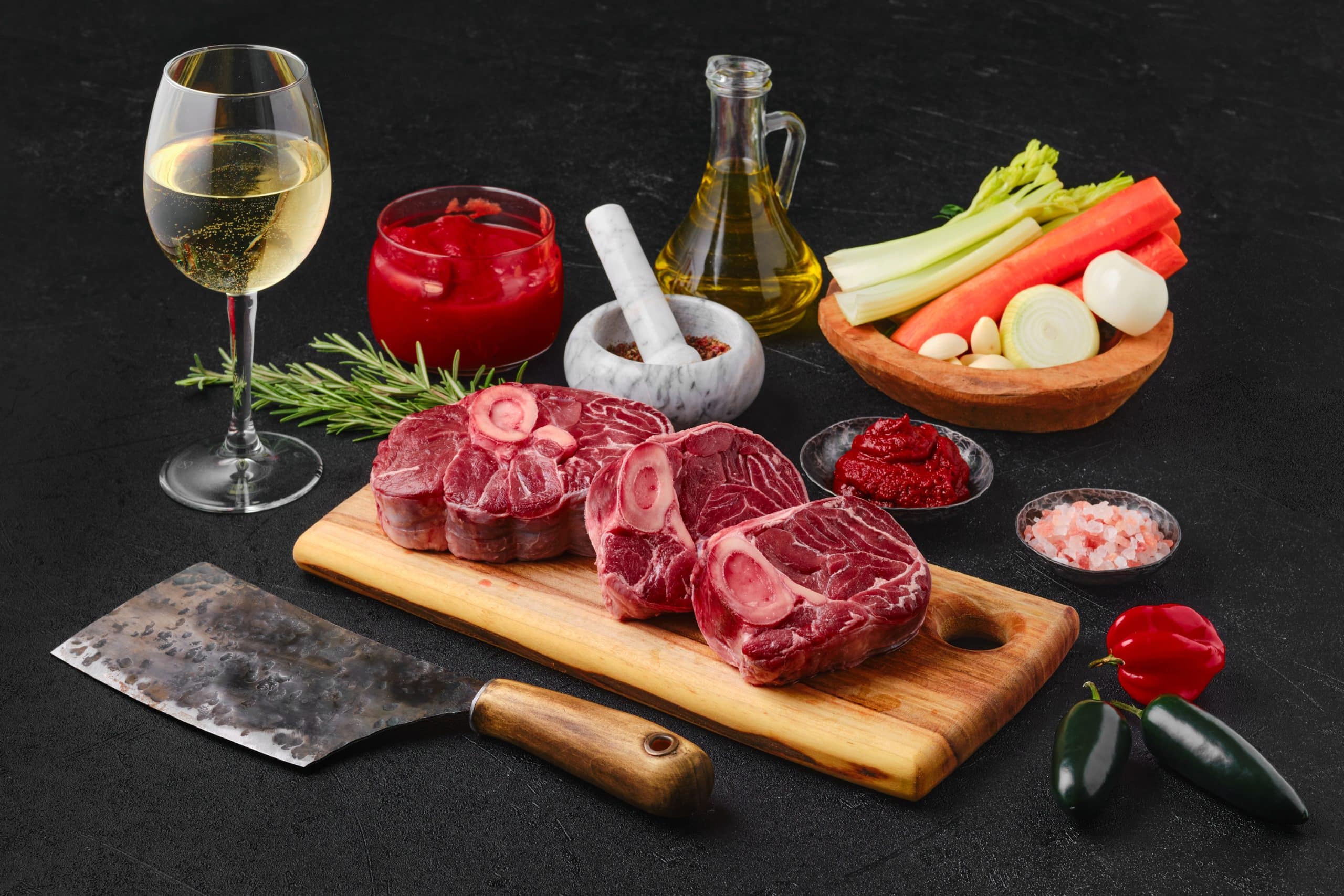What’s the Key to a Flavorful Italian Osso Buco with a Velvety Sauce?

The Italian Osso Buco, literally meaning "bone with a hole," refers to a traditional Italian dish that combines slow-cooked veal shanks with a tempting, creamy sauce. The dish, rich in tantalizing flavors, offers an unparalleled culinary experience. But what makes the Osso Buco a favorite? Is it the tender meat, the marrow-filled bone, or the sauce? The answer lies in the meticulous process of crafting this masterpiece. This article aims to guide you through the essentials of concocting a flavorful Italian Osso Buco with a velvety sauce, a dish that promises to excite your taste buds.
Deciphering the Art of Choosing the Right Beef Shanks
Selecting the perfect beef shanks is the first step towards a flavorful Osso Buco. This section will guide you through the key factors to consider while choosing the beef shanks for your Osso Buco.
This might interest you : What you need to know about the le creuset mystery box
As Osso Buco is traditionally a veal dish, it is typical to use veal shanks. However, feel free to replace veal with beef shanks if you prefer. Regardless of your choice, remember that the cut should have a rich marrow, which enhances the flavor of the sauce.
When choosing your shanks, try to get pieces that are evenly cut and approximately the same size to ensure equal cooking time. Moreover, the shanks should have a good proportion of meat and bone, which contributes to the overall texture and taste of the dish.
Also to see : Can You Prepare a Gourmet Smoked Salmon Blini with the Perfect Accompaniments?
Master the Techniques of Searing the Meat
Searing the meat is a crucial step in the Osso Buco recipe. Searing involves browning the meat over high heat before slow-cooking. This step enhances the flavor by forming a caramelized crust on the surface, which is then deglazed to create a rich sauce.
Begin by patting the shanks dry and seasoning them generously with salt and pepper. Heat some oil (preferably olive oil) in a large pan, and when it’s hot enough, add the shanks. Cook until they form a brown crust on each side, which usually takes around five minutes per side.
Once the meat has been appropriately seared, remove it from the pan and set it aside. Do not discard the leftover brown bits in the pan; these hold a lot of flavors and will be used in the sauce.
Crafting the Perfect Sauce for Osso Buco
The next step is to prepare the sauce, which is arguably the soul of any Osso Buco dish. A good sauce complements the tender shanks and enriches the overall flavor. Here, we will guide you through the process of making a velvety sauce.
Begin by reducing the heat and adding chopped onions, carrots, and celery to the same pan used for searing the meat. Cook until the vegetables soften, making sure to stir frequently.
Next, you’ll employ a technique called deglazing, which involves adding a liquid — usually wine — to the hot pan to dissolve the caramelized bits left from searing the meat. Use about one cup of dry white wine for deglazing. While the wine is still simmering, scrape off the flavor-filled bits stuck at the bottom of the pan. This process adds depth and complexity to your sauce.
After deglazing, add some tomato paste and continue to cook for a few minutes, then pour in the broth. Continue cooking for some time until the sauce starts to thicken.
Employing the Slow-Cooking Technique
After you’ve prepared the sauce, it’s time to slow-cook the shanks. Slow-cooking, or braising, is a cooking technique that involves cooking food at low temperatures for a long time. This method is ideal for tough cuts of meat like shanks, transforming them into tender pieces that fall off the bone.
Nestle the seared shanks into the simmering sauce, ensuring they’re covered. You could do this in a slow cooker, pressure cooker, or even in a casserole dish in the oven. If you’re using an oven, preheat it to 325°F (165°C).
Cover the pot and let it simmer for about 2-3 hours, or until the meat becomes tender. Remember, patience is the key here; don’t rush this process. The long, slow cooking time will allow the flavors to meld together, creating a delectable meat that’s worth the wait.
Finishing Touches: Gremolata and Serving Suggestions
Once your Osso Buco is cooked, you’re almost ready to serve. But first, let’s add a touch of brightness to the dish with a gremolata. Gremolata is a zesty Italian condiment made from lemon zest, garlic, and parsley. It cuts through the richness of the Osso Buco and brings a burst of freshness.
Sprinkle the gremolata over the Osso Buco just before serving. As for side dishes, traditionalists prefer serving the Osso Buco with Risotto alla Milanese, a saffron-infused rice dish. However, mashed potatoes or polenta can also make excellent accompaniments.
So there you have it; the keys to a flavorful Italian Osso Buco with a velvety sauce lie in careful selection of the shanks, proper searing, slow-cooking, and the right finishing touches. Once you master these steps, you’re on your way to a culinary delight that’s sure to impress.
The Intricacies of the Dutch Oven: A Medium for Slow Cooking Osso Buco
Slow cooking is at the heart of Osso Buco, and the Dutch oven is the perfect medium to facilitate this. Named after a traditional heavy cooking pot, the Dutch oven has versatile uses, from baking to braising. For Osso Buco, it provides an even heat distribution, making it an excellent choice for slow cooking.
To start, place the Dutch oven on the stove, add the tomato paste and the beef shanks, and pour in the sauce. Add a few sprigs of rosemary, thyme, and bay leaves for an aromatic touch. Now, remember, the secret to flavorful Osso Buco lies in the cooking time. Adjust the heat to maintain a gentle simmer and let the veal shanks cook slowly.
While the Osso Buco is cooking, resist the temptation to lift the lid frequently. Each time you do, you let out precious heat and steam that is essential for the cooking process. Instead, trust the Dutch oven and the slow cooking process. After about 2-3 hours, the meat should be fork tender, indicating that it is ready.
Choosing the Right Beverage: White Wine or Red Wine?
A key element in Osso Buco – and indeed in any Italian cuisine – is the wine used for deglazing. The question often arises: white wine or red wine? Each adds a different dimension to the dish.
White wine, with its light and crisp flavor, enhances the natural taste of the veal shanks. It is perfect for deglazing as it balances the heavy, meaty flavors. However, if you prefer a more robust flavor, opt for red wine. It adds depth and richness to the sauce, making the dish more hearty and full-bodied. Regardless of your choice, make sure to use a good quality wine, one that you wouldn’t mind drinking. After all, the quality of the wine can dramatically impact the final taste of the Osso Buco.
Conclusion: The Finale of the Italian Osso Buco
In conclusion, mastering the key elements of making an impeccable Italian Osso Buco with a velvety sauce isn’t a quick process. It requires patience, the right ingredients, and precision. From selecting the right veal shanks to understanding the nuances of using a Dutch oven for slow cooking, every detail matters.
The choice of wine for deglazing, whether white or red, can alter the flavor profile of the dish, making it a fun variable to experiment with. The final touch of gremolata brings a freshness that contrasts and complements the rich Osso Buco beautifully.
Remember, the beauty of Italian cuisine lies in its simplicity and respect for ingredients. With practice and patience, you too can create an Osso Buco that would make any Italian nonna proud. So put on your apron, pour yourself a glass of wine, and embark on the fulfilling journey of cooking Osso Buco. Buon Appetito!
